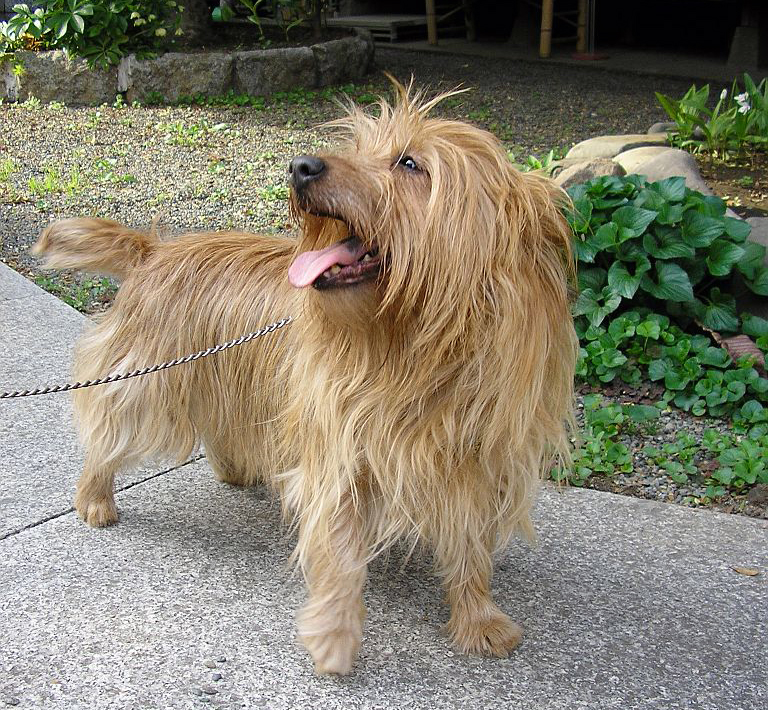- Australian terrier
image_caption = An adult Australian Terrier
name = Australian Terrier
country =Australia
nickname = Aussie
fcigroup = 3
fcisection = 2
fcinum = 008
fcistd = http://www.google.com/search?q=cache:qN5YxOhiJ7kJ:www.fci.be/uploaded_files/008gb98_en.doc+site:www.fci.be+%228/+12.+03.+1998%22&hl=en&ie=UTF-8
akcgroup = Terrier
akcstd = http://www.akc.org/breeds/australian_terrier/index.cfm
ankcgroup = Group 2 - Terrier
ankcstd = http://ankc.org.au/home/breeds_details.asp?bid=47
ckcgroup = Group 4 - Terriers
ckcstd = http://www.ckc.ca/en/Default.aspx?tabid=99&BreedCode=AST
kcukgroup = Terriers
kcukstd = http://www.thekennelclub.org.uk/item/65
nzkcgroup = Terriers
nzkcstd = http://www.nzkc.org.nz/br208.html
ukcgroup = Terriers
ukcstd = http://mail.ukcdogs.com/UKCweb.nsf/80de88211ee3f2dc8525703f004ccb1e/75a4ea89a8a3cacc8525704d004d40aa?OpenDocumentThe Australian Terrier is a small breed of
dog in theterrier family.Characteristics
Appearance
The Australian Terrier stands around 25 centimeters high at the
withers and weighs around 7 kilograms. It is a low-set dog; the length of its body is longer than its height at the withers. The Aussie has a high-set tail that is now not docked in Australia.The head of the Australian Terrier is elongated, with a slight
stop and pricked ears. TheANKC breed standard describes the dog's look as "hard bitten" and "rugged". The eyes are small, dark, and oval and must have a keen terrier expression. The leather of the nose runs up to the bridge of the muzzle, which is described as "strong".The dog's coat is rough or harsh to the touch, with a soft
undercoat and a distinctive ruff around the neck. Australian Terriers shed little hair. The breed standard specifies that it should be untrimmed, but some prefer to neaten the dog for the show ring. Acceptable colors are blue and tan, red or sandy.The Australian Terrier has medium sized triangular ears which are very flexible. The ruff around the neck complements its appearance. It is a great companion dog.
Health
There are three completed health surveys for Australian Terriers.http://users.pullman.com/lostriver/breeddata.htm Dog Longevity Web Site, Breed Data page. Compiled by K. M. Cassidy. Retrieved July 8, 2007] Two surveys, one in 1997 and one in 2002, have been conducted by the Australian Terrier Club of America.http://australianterrier.org/survey_02.htm Australian Terrier Club of America. 2002 ATCA Health Survey Results. [Note: There is not a direct link to the ATCA 1997 Health Survey, but the results are discussed extensively in the 2002 Survey Report] Retrieved February 2007 ] The Club is currently collecting data for their next survey.http://australianterrier.org Australian Terrier Club of America home page. Retrieved July 13, 2007] The UK Kennel Club has a 2004 survey, but it has a much smaller sample size than the Australian Terrier Club of America surveys.http://www.thekennelclub.org.uk/item/570 Kennel Club/British Small Animal Veterinary Association Scientific Committee. 2004. Purebred Dog Health Survey. Retrieved July 5, 2007 ] Some of the respondents in the American surveys were from Australia, but none of the Australian Terrier clubs in Australia appear to have conducted, or be in the midst of conducting, a survey.
Mortality
In both 1997 and 2002 Australian Terrier Club of America surveys, median longevity of Australian Terriers was 11 years (total sample size of 230 deceased dogs). In the UK Kennel Club 2004 survey, median longevity was 12.1 years, but the sample size was only 11 deceased dogs. 11 years is a typical median longevity for purebred dogs in general, but on the low end of longevities for breeds similar in size to Australian Terriers.http://users.pullman.com/lostriver/weight_and_lifespan.htm Dog Longevity Web Site, Weight and Longevity page. Compiled by K. M. Cassidy. Retrieved July 5, 2007]
Major causes of death in the 2002 survey were cancer (67%), old age (17%), undetermined (16%), and diabetes (13%).
Morbidity
Among 619 living dogs in the 2002 Australian Terrier Club of America survey, the most commonly reported health problems were endocrine (primarily diabetes), allergic dermatitis, and musculoskeletal (primarily luxating patella and ruptured cranial cruciate ligament). Other conditions reported among more than 4% of the surveyed dogs were adult onset cataracts and ear infections. The much smaller 2004 UKC survey, with 28 living dogs, suggested similar health concerns.
History
The Australian Terrier was the first Australia-bred Australian dog to be shown, and the first to be recognized overseas. Its origins are uncertain, but its immediate ancestor was without doubt developed in the United Kingdom in the early 1800s from the precursors of today's British and Scottish terriers. Some of these breeds are now extinct, but the Aussie likely has a mixed ancestry comprising the same dog types that produced today's Yorkshire, Dandie Dinmont, Manchester, Irish, and Cairn terriers.
A new rough-coated terrier was evident in Australia by the late middle-nineteenth century; the selectively-bred terrier was used for rodent and snake control, as a
watchdog , and occasionally as aherding dog .The first Broken-coated Terriers were exhibited in
Melbourne in 1868 and the Australian Rough-Coated Terrier Club was founded in Melbourne in 1887. The breed was exhibited as the Australian Terrier, Rough-Coated in 1899.Official breed status was granted in the UK in 1933 and in the US in 1960.The Australian Terrier was recognized by the
United Kennel Club in 1969.References
External links
* [http://www.australianterrier.org/ Australian Terrier Club of America]
* [http://www.geocities.com/atcsa1997/ The Australian Terrier Club of South Australia]
Wikimedia Foundation. 2010.

